|
|

XP Days Benelux 2010 will be held in Kapellerput, Heeze (near Eindhoven), The Netherlands on 25-26 November
The program for XP Days Benelux has been published. This year we have more sessions than ever before: 41 sessions over 2 days. As always, it’s going to be hard to select only one session from the five parallel tracks.
I’ll be presenting “Agreeing on Business Value with Systems Thinking” with Portia Tung. I’ll be doing a tryout of this presentation, which has been updated after presenting it at Agile 2010. Come to the Agile/XP Belgium user group meeting on Tuesday 26th of October.
If you want to see a tryout of the “Database Change Management” session, join us in the Agile/XP Belgium user group meeting on Tuesday 5th of October.
XP Days session tryout
 IHC hosts the next Agile/XP Belgium usergroup meeting. There will be two sessions in parallel IHC hosts the next Agile/XP Belgium usergroup meeting. There will be two sessions in parallel
Session 1: “A journey into Database Change Management” by Jochen Jonckheere and Pascal Mestdach. This is a tryout for XP Days Benelux.
Abstract:
We will bring you the story of our journey into database change management. We share our experiences with concrete examples/common situations and explain the different parts of Database Change Management along the way. During our journey we encountered several problems. We let participants reflect on how they would solve these problems, before we show the solution we picked. This is an interactive technical session where you will see 2 developers working together, writing some small sql scripts, breaking and fixing automated builds and even in the end a tool for handling Database Change Management in an automated way in the .NET environment.
Session 2: To be decided
Agenda:
- 18:00 – 19:00 – Welcome with snacks and drinks
- 19:00 – 21:00 – Parallel Sessions
Register here for this free meeting.
Address: Legeweg 157 E/02, 8020 Oostkamp, Belgium
 They’re back! They’re back!
Couldn’t come to XP Days Benelux 2009? You missed a lot of great sessions.
Even if you did go to XP Days Benelux 2009, you missed several great sessions, because the program committee stupidly scheduled great sessions at the same time in each of the five parallel tracks.
Or maybe you want to send your colleagues to those great sessions you attended.
Well now you can, because 8 of your favourite sessions are being presented again at Mini XP Day Benelux on April 26th, 2010.
What’s in it for me?
You could learn more about
Mini XP Days Benelux remains the place to exchange ideas and share experiences about Agile in an open and relaxed atmosphere.
Don’t wait too long
Register quickly because the event is limited to 60 participants and the event usually sells out.
See you on April 26th in Kappelerput, just to the south of Eindhoven, near the Dutch-Belgian border (which might have an effect on the availability of beers…)

It’s been a busy November
Last week we organised XP Days Benelux and I’ve just about recovered from it. It was fun, as usual, and participants seemed generally happy with the event. You can see for yourself in the reports, participant retrospective and session feedback.
There are also a lot of things which could be better. The organisers are already busy setting up a retrospective and next year’s events.
A full report will follow later.
If you’ve written about XP Days Benelux, let us know. We gather all the reports on the conference website.
If you have any feedback or ideas for improvement, let us know. Even better, join the organising committee and realise your ideas.
Organising a conference is fun even if you’ve never done it before. There are enough experienced organisers to pair with. It does take some time and effort, so make sure that you’ll be able to invest in the conference. In return, you get the chance to take part in a non-IT Agile project.
Tried Out
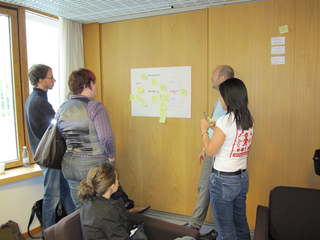 When presenters propose sessions for XP Days Benelux, we always recommend they try out their session, as many times as possible. We should all know the power of iteration and feedback. You need some time to get it right. If you’re slow like me, you might need years to get it right. When presenters propose sessions for XP Days Benelux, we always recommend they try out their session, as many times as possible. We should all know the power of iteration and feedback. You need some time to get it right. If you’re slow like me, you might need years to get it right.
The first tryout of the “Solve Conflicts without Compromise” session was run as a “Birds of a Feather” session several years ago at the SPA conference. The session (and the technique) worked, but only barely. Then, two breakthroughs happened at the same time:
Suddenly, the technique became a lot clearer. Bill Dettmer’s explanation is very clear and practical; the session at Agile 2008 showed that it worked and could be fun.
Solve Conflicts without Compromise
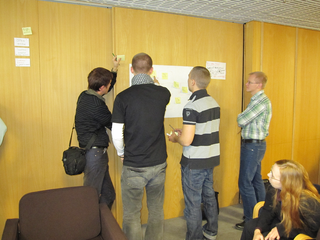 So, after a few more iterations, an updated session was created. It’s now been run twice: So, after a few more iterations, an updated session was created. It’s now been run twice:
- At Agile Tour Besançon, in French. The participants gave a lot of useful feedback at the retrospective.
- At the Scandinavian Agile open space, in English. The pictures show the three groups analysing a conflict for their “customers”. There was no time for a retrospective, because the conference was closing. I hope the three clients will blog or email me about their experience.
The next two runs will be at the Belgium Agile/XP User Group meeting on November 5th 2009 and at the XP Days Benelux conference on November 24th.
So, what are the 7 steps?
- Create a blank Conflict Resolution Diagram (CRD) like in the image below. 5 boxes connected with arrows. Easy.
- Articulate the conflict. State the problem in one of two forms, both impossible choices between conflicting prerequisites:
- One chain of reasoning says “DO THIS”; another chain of reasoning says “DON’T DO THIS”. Now I have to choose: DO THIS OR DON’T DO THIS? I can’t have both.
- I need two things, A and B, but they’re mutually exclusive. Now I have to choose: HAVE A OR HAVE B? I can’t have both.
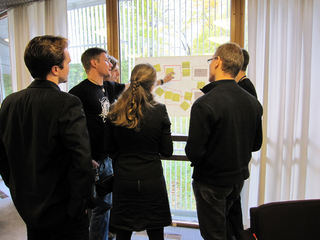 Determine the goal and requirements on each side? Why do we need those two conflicting things? Because of two requirements. Why do we need those two requirements? Because we need them to reach a common goal. Determine the goal and requirements on each side? Why do we need those two conflicting things? Because of two requirements. Why do we need those two requirements? Because we need them to reach a common goal.- Evaluate the reasoning. Throughout the whole exercise we must ensure we maintain clarity: is each step in the reasoning crystal clear and well-understood by everyone? Is the reasoning clear?
- Develop underlying assumptions. If the CRD says “To achieve X we need Y”, ask “Why do we need Y to achieve X?”. All the answers are the underlying assumptions of the reasoning. Use “extreme wording” to make the assumptions stand out and almost beg to be invalidated. For example: “Why do we need to introduce Test Driven Development to achieve better quality?” Because…
- TDD is the only way to improve quality
- TDD is the most fun way to develop software
- TDD catches all errors
- Evaluate the assumptions. Which assumptions are valid? Which assumptions are invalid? Which assumptions could be challenged. If there are no valid assumptions behind a step in the reasoning, the reasoning is invalid. At this point, the whole conflict may have “evaporated”.
- Hard: Create injections. This is the creative bit where we find ideas to invalidate those assumptions that hold us back from creating a win-win situation, one where we achieve our goal in a way that satisfies everyone involved.
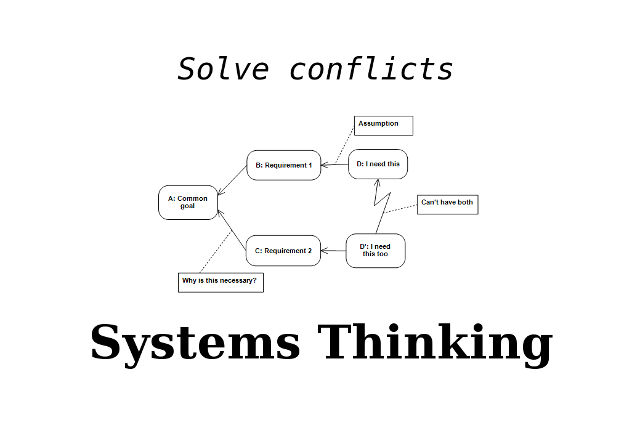 Why is this difficult? Why is this difficult?
When I see the participants in action, there are some difficulties that appear every time:
- It’s hard to maintain the consultant’s stance and only ask questions. That’s why we have strict rules about what the consultants can do: they can only ask a limited set of questions.
- We want to jump to the solution immediately without taking the time to understand the real problem. That’s why the session doesn’t allow talking about solutions, only about problems.
- We censor our assumptions. Instead of brainstorming all our assumptions, we only talk about those that seem reasonable. That’s why there’s a lot of pressure in the session: you have to come up with at least 25 assumptions in 5 minutes. That’s just not possible if you think about the assumptions.
- The most interesting assumptions are those that we no longer think about, the things that are “common sense”. That’s why we have people external to the problem questioning the client and why we bring in some “fresh blood” with a fresh perspective halfway through the session.
- It hurts when we really think about a problem. It’s easier to just settle for a compromise. That’s why we can’t accept any solution where one of the involved parties is not completely satisfied with the outcome.
What’s in it for me?
- The CRD provides a structured method to investigate a difficult conflict and channel our creativity.
- You don’t have to settle for compromise and mediocrity. You can get what you really need.
- It’s a lot easier to bring about changes if everyone affected benefits. As Machiavelli noted: “You will only get lukewarm support from those who will benefit from the change and strong resistance from those who stand to lose”. What if there were no losers?
- Your projects can deliver more business value per cost if you can find the breakthrough ideas that make those painful tradeoffs (or more correctly: horse trading) between stakeholder goals unnecessary?
- You can get more sales if your competitors offer “EITHER/OR” solutions and you can offer “AND” solutions. But first the customer has to regain hope that a solution is possible. Going through a CRD exercise with a customer and offering to invalidate all the assumptions that cause their conflict is an offer they can’t refuse.
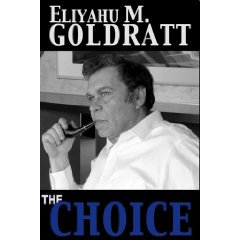 What do I need? What do I need?
- A bit of time. Most participants got several ideas to resolve their conflict within the 90 minutes of the session.
- Some simple materials: pen, paper and plenty of Post-Its
- The willingness to think hard
- The openness to share all assumptions
- The courage to challenge every assumption, even those that are “holy” or common sense. Especially those.
It’s simple, but not easy. The question is: do you want an easy life or a meaningful life? That’s the choice you have to make.
Oh! “Easy OR meaningful”? That sounds like a conflict! Why can’t I have both?
How would you evaporate this conflict?
|








